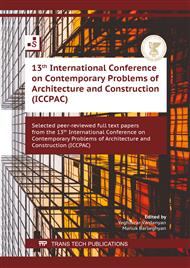[1]
A.B. Zolotov, P.A. Akimov, V.N. Sidorov, M.L. Mozgaleva, Discrete-continual finite element method. Applications in Construction, ASV, Moscow, (2010).
Google Scholar
[2]
N.I. Senin, P.A. Akimov, Mathematical fundamentals of linear three-dimensional analysis of load bearing structures of multistory buildings with the use of discrete-continual model, Vestnik MGSU. 2 (2011) 44-49.
Google Scholar
[3]
A.Tamrazyan, L.Avetisyan, MATEC Web of Conferences. 86 (2016) 01029.
Google Scholar
[4]
N. Blokhina, A. Galkin, The application of ANSYS software package in limit load analysis of structures made from anisotropic nonlinear elastic materials, MATEC Web of Conferences. 117 (2017) 00019.
DOI: 10.1051/matecconf/201711700019
Google Scholar
[5]
D. Panfilof, A. Pischulev, K. Givadetdinov, Ind. & Civ. Eng. 3 (2014) 80-84.
Google Scholar
[6]
N. Karpenko, B. Sokolov, O. Radaykin, Ind. & Civ. Eng. 1 (2013) 28-30.
Google Scholar
[7]
V. Murashkin, G. Murashkin, MATEC Web of Conferences. 196 (2018) 04008.
Google Scholar
[8]
SP 63.13330.2018 Concrete and reinforced concrete structures. General provisions. 170 (2019).
Google Scholar
[9]
D. Panfilof, A. Pischulev, K. Givadetdinov, Ind. & Civ. Eng. 3 (2014) 80-84.
Google Scholar
[10]
D.K Zimos, V.K Papanikolaou, A.J. Kappos, P.E. Mergos, Shear-Critical Reinforced Concrete Columns under Increasing Axial Load, ACI Structural Journal. 117-5 (2020) 29 – 39.
DOI: 10.1680/jmacr.21.00034
Google Scholar
[11]
V. Blazhko, Hous. Constr. 3 (2017) 17-21.
Google Scholar
[12]
B. Sokolov, Y. Mironova, Hous. Constr. 5 (2014) 60-62.
Google Scholar
[13]
V. Lyublinskiy, Build. & Reconst. 5 (2019) 17-22.
Google Scholar
[14]
A. Tamrazyan, D. Popov. MATEC Web of Conferences. 117 (2017) 00162.
Google Scholar
[15]
ETABS, manual., Linear and Nonlinear Static and Dynamic Analysis and Design of Three-Dimensional Structures, Computers and Structures Inc, Berkeley, California, (2004).
Google Scholar
[16]
O.C. Zienkiewicz, R.L. Taylor, The Finite Element Method Set, Sixth Edition. Butterworth-Heinemann, (2005).
Google Scholar
[17]
S.F. Klovanich, D.I. Bezushko, The finite element method in the calculation of spatial reinforced concrete structures, Publishing house of ONMU, Odessa, (2009).
Google Scholar
[18]
Hola Musa, Non-linear Deformations and Ultimate Bearing Capacity of Vertical Diaphragms of Monolithic Multistory Buildings. PhD dissertation. Moscow State University of Civil Engineering.
Google Scholar


